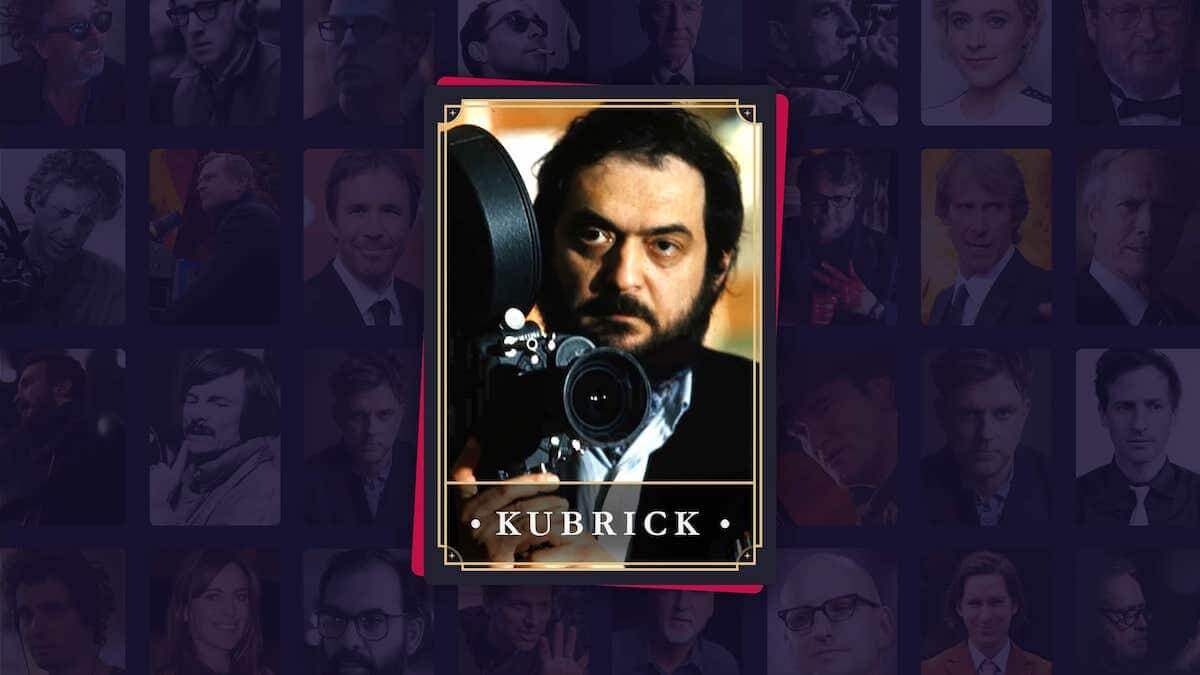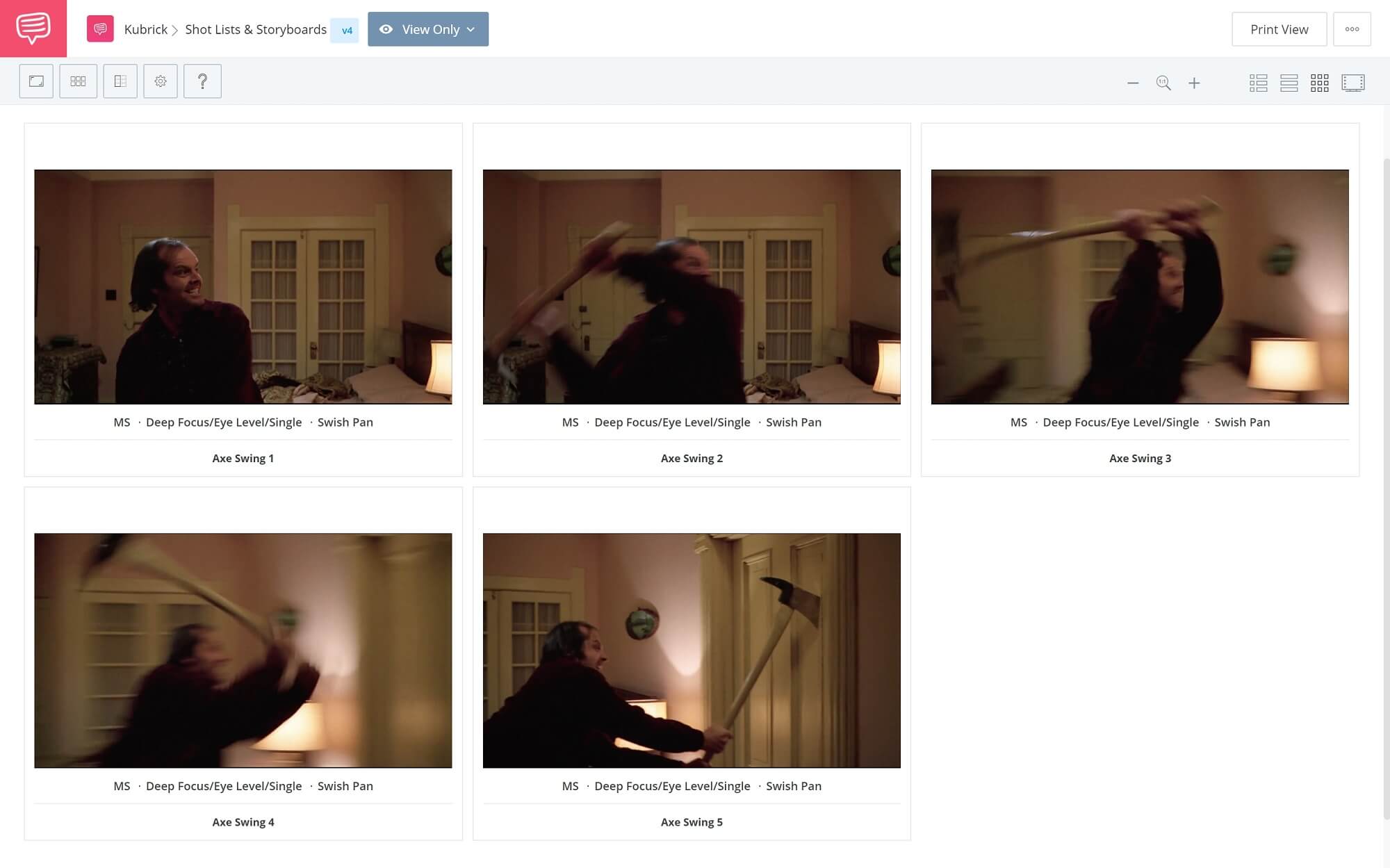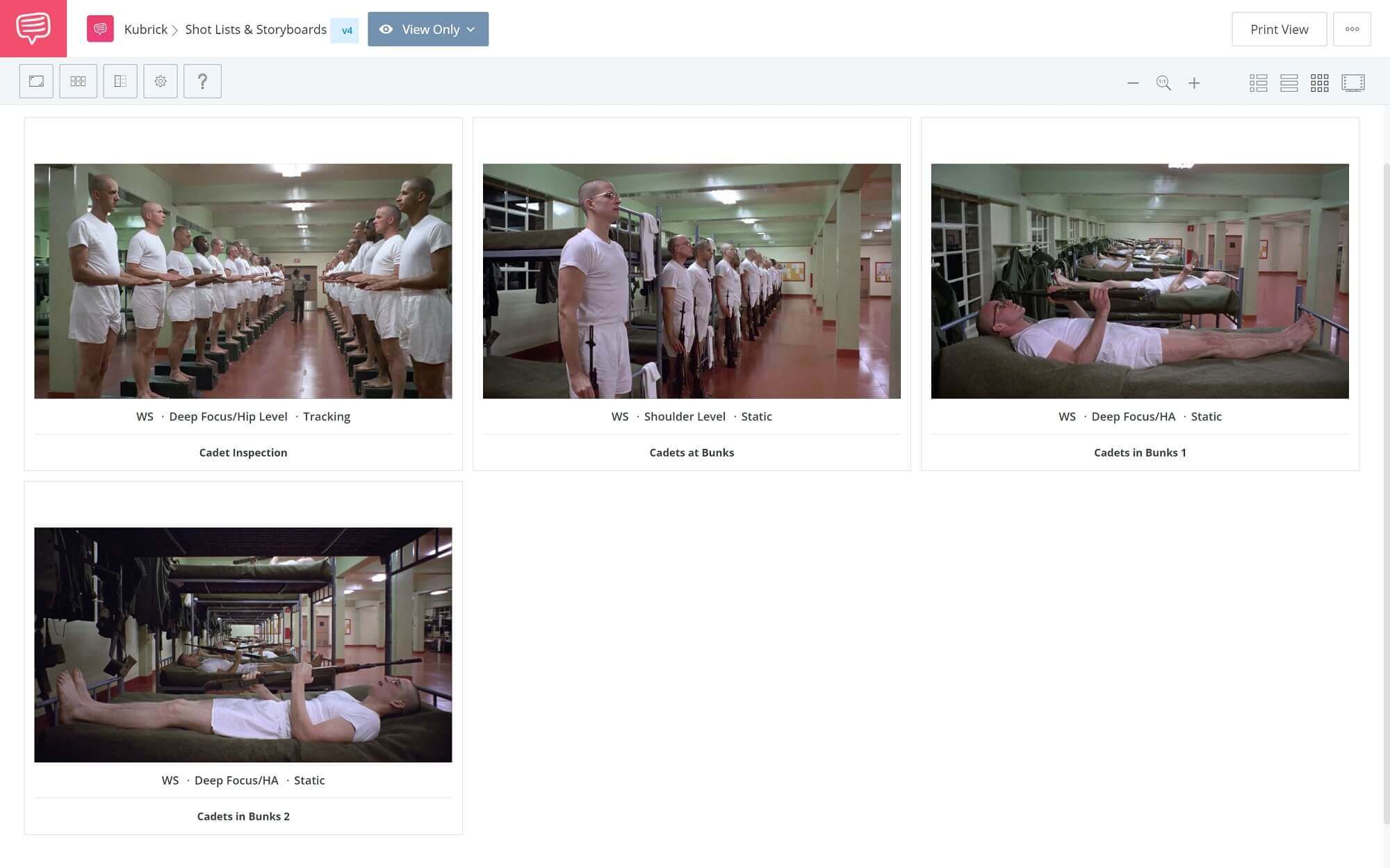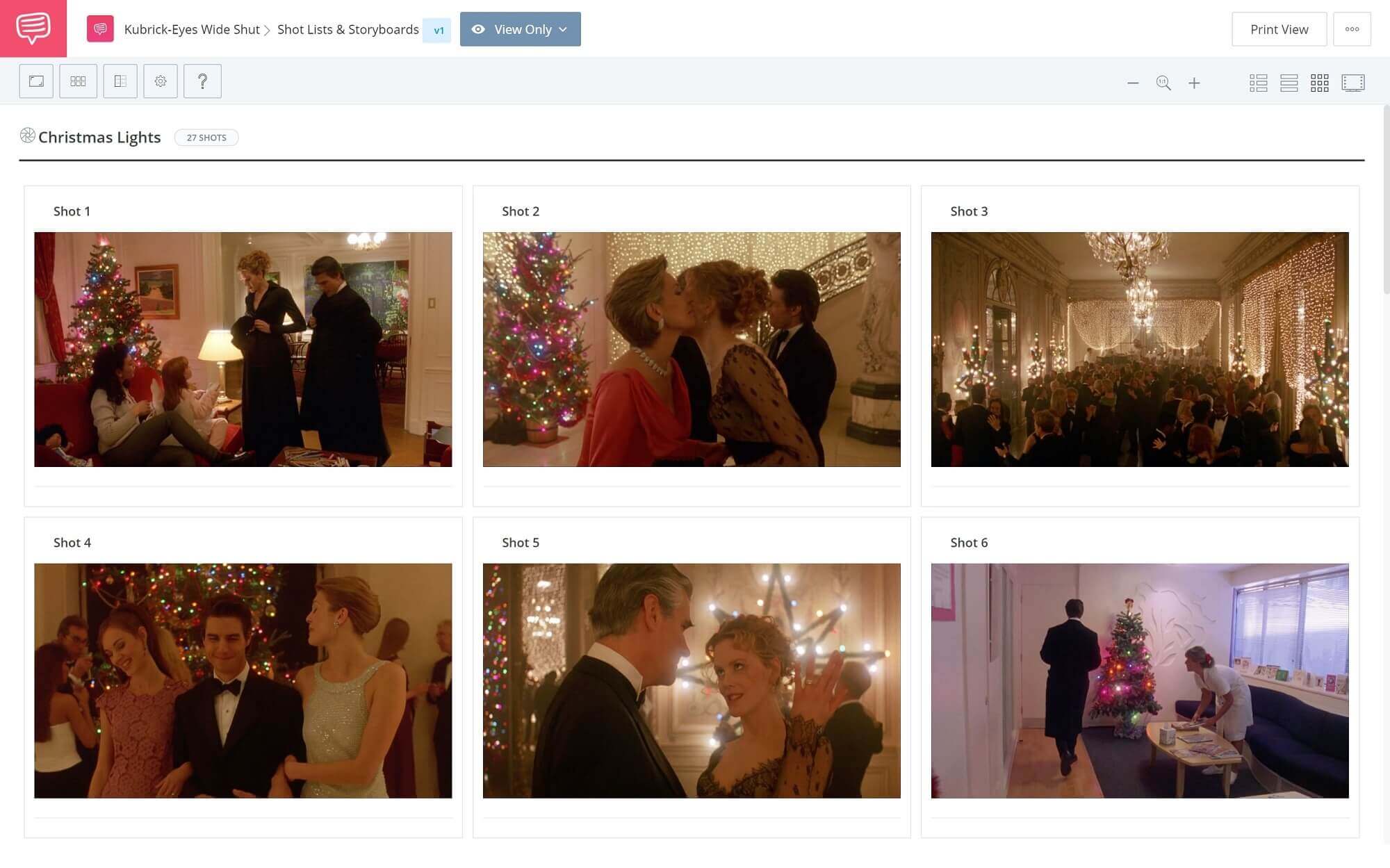The saying goes, “If you’re going to steal, steal from the best.” So, is Stanley Kubrick the best? For many filmmakers, the immediate answer is yes. The harder question is “why?” Like a great magician, we appreciate the end result without knowing how it was done. There is certainly a lot of “process” in his work. Kubrick doesn’t just conjure greatness out of the ether. The preparation, the details, the ability to take as much time on a project as he wanted. These elements can be seen, heard, and felt on the screen. Here we present the Stanley Kubrick directing style and some insights as to what makes it so captivating.
Table of Contents
Everything you need to know about Stanley Kubrick
1
Cinematography
Movement • Framing • Lighting
camera movement
Motivate your camera movement
A moving camera can add a lot to your cinematography. It can make scenes chaotic, exciting or dreadful. The key to a successful camera movement is to make sure that it is motivated.
When it comes to directing the camera, a filmmaker like Stanley Kubrick chooses his moments carefully.
When we follow a character moving through their environment. When we witness a character entering a new world. Or when we capture the chaos of war.
In The Shining, we have an example that uses camera movement to enhance the power of a character, but not a human character, per se.
The Overlook Hotel is a haunted and powerful place. One way this power is shown is through the moving camera, which we will call the “Overlook POV.” From the second they move in, this Overlook POV stalks the Torrence family.
In the next scene, the "Overlook POV" is practically chasing Danny through the empty hallways. Until...
In the climax of the film, the Overlook POV takes an active role in Jack’s murderous rampage. Take a look at the shot list in StudioBinder below:
With each swing of the axe, the camera whip pans to the right, stopping on impact. By connecting the camera to Jack’s movement, Jack’s physical power is now propelled by the Overlook.
Whip Pan DEFINITION
WHAT IS A WHIP PAN?
A whip pan (aka a swish pan) is a rapid pan along the horizontal axis.
Paul Thomas Anderson uses whip pans to transition from scene to scene in films like Boogie Nights.It is an unusual camera movement but there is a reason for it. Are there moments in your project when a camera movement is motivated? Use StudioBinder to plan out these shots.
Related Posts
Framing and Shot Composition
Compose frames like Kubrick
The time has come to start storyboarding your shots. There is not a perfect formula for this but there is one thing to always keep in mind:
Presentation is everything. This presentation goes beyond building sets. You need to consider shot composition techniques to take full advantage of those sets. With everything composed in front of the camera, the mise-en-scene is complete. And few directors control the elements of mise-en-scene better than Stanley Kubrick.
Mise-en-scene Explained with Kubrick • Subscribe on YouTube
Consider this set from Stanley Kubrick's military feature Full Metal Jacket. The presentation of the barracks is clean, orderly and uniform. Just like the cadets must be.
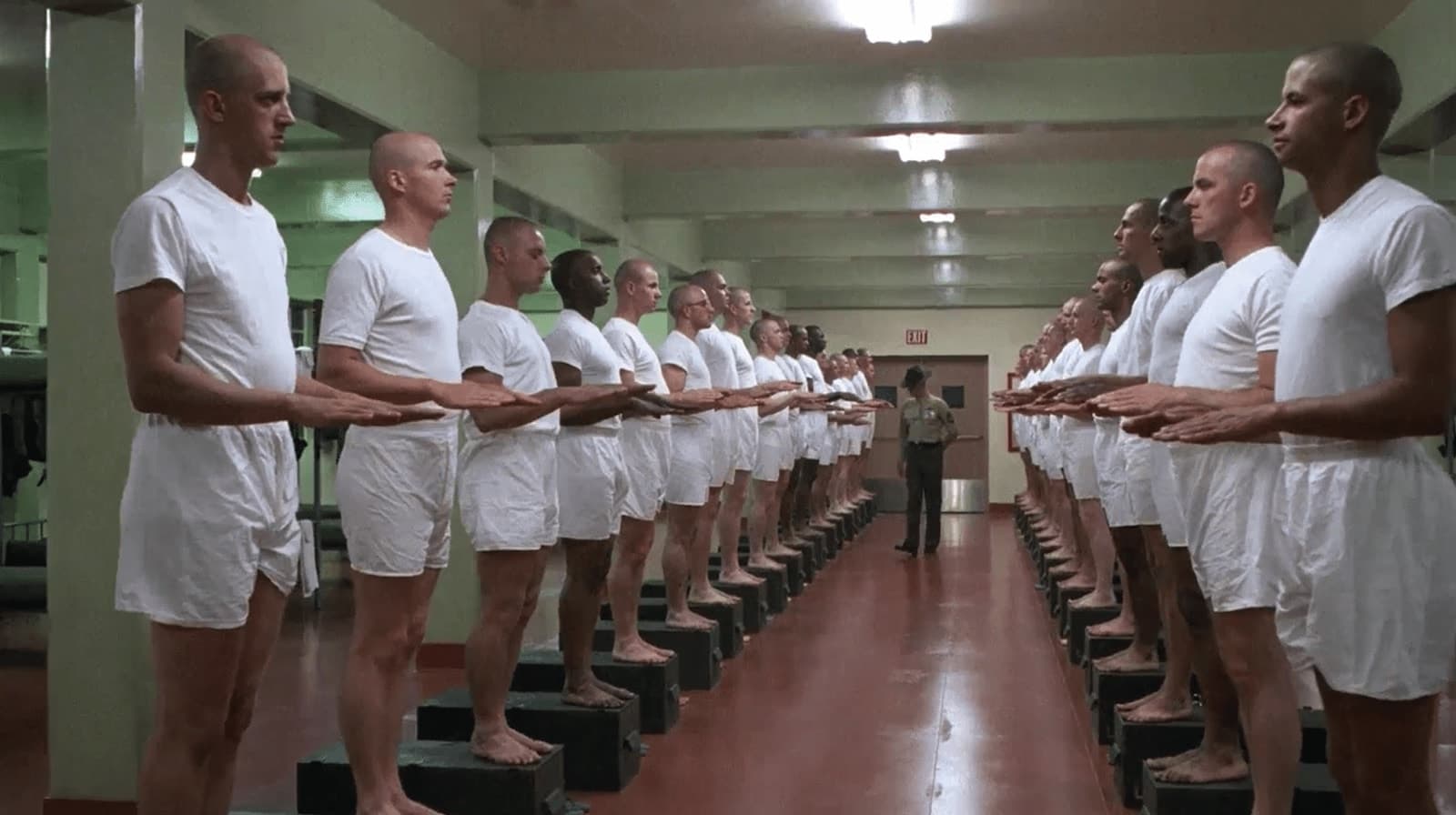
Framing matters
But Kubrick takes this one step further by framing his shots to maximize this idea. The use of symmetry and the choreographed movements devalue the individual cadet. They have given up their individuality and have joined a collective body.
Before we take a look at the shot list, feel free to familiarize yourself with our shot listing feature below:
Now that we're a little more comfortable, let's take a look.
These super-organized frames dominate the first half of the film.
The second half, when the cadets are at war, loses this rigid framing because the world has lost its rigidity. It is coming apart at the seams and the composition/framing follows suit.
Related Posts
Lighting
How Kubrick uses practical lighting
Barry Lyndon is a masterclass in film lighting. Many films have used natural lighting techniques to great effect but, again, Kubrick takes it even further.
For the nighttime scenes, candles were the only source of illumination. But there was a problem: the lenses could not capture images in these low-light conditions.
So, Kubrick turned to none other than NASA to develop a lens system that worked. Is this another example of Kubrick's legendary hubris or is there something more?
Consider what effect this lighting style has for these characters. The intimacy between Barry and Lady Honoria is on the page but the images push beyond that.
There is the soft, natural glow from the candlelight. Perfect for establishing intimacy. But there is also a flaw in these NASA lenses that has an unintended effect. Because the aperture is wide open, the depth of field is almost nonexistent.
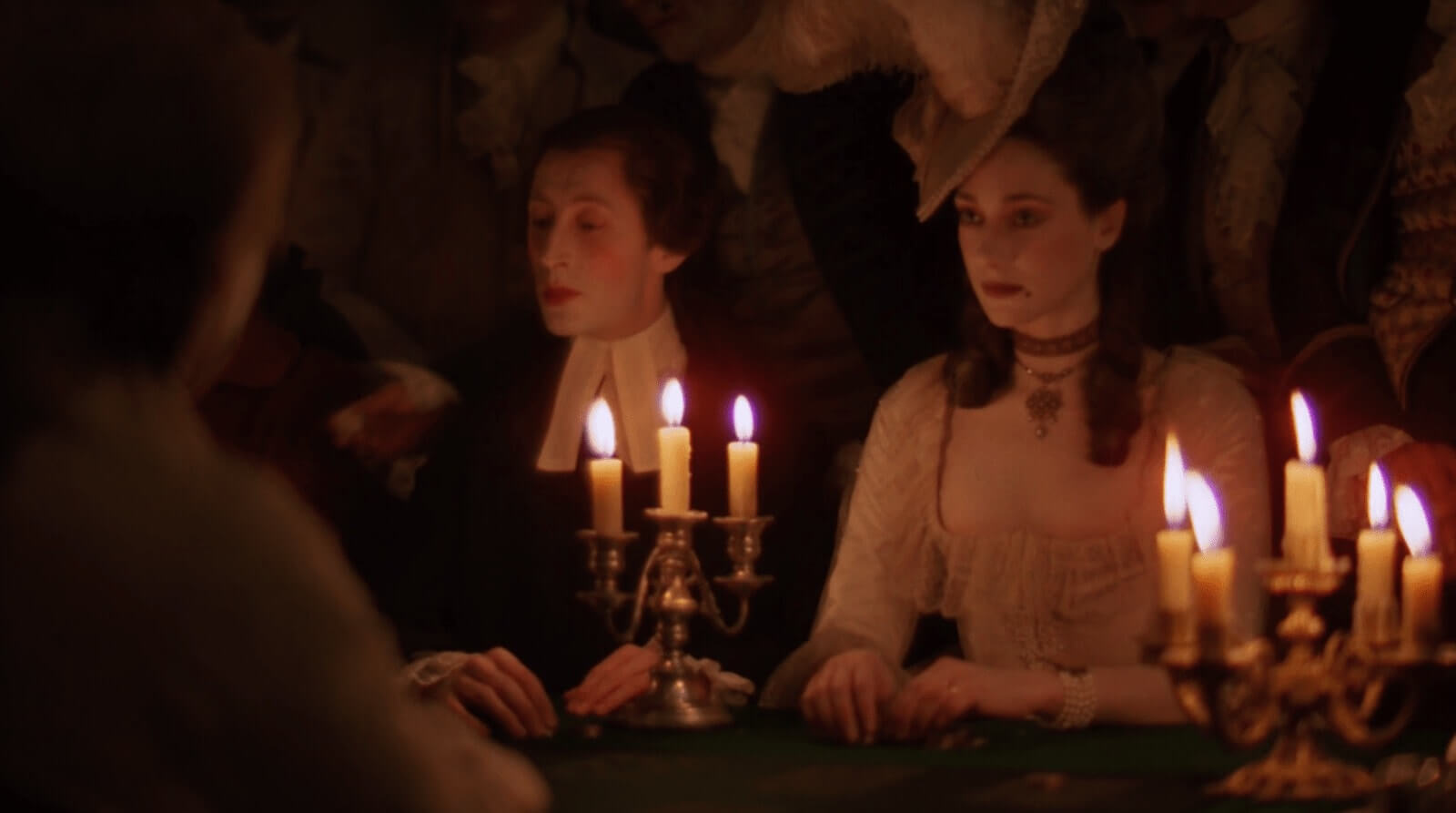
Hard to tell between characters and background
This low depth of field separates the characters from the background. They become distanced from the crowd as they occupy each other's attention completely. Kubrick shows us here that limitations can produce benefits.
In his final film, Eyes Wide Shut, Kubrick brought lights directly into the scene. Christmas lights, to be exact. It's one thing to establish the setting of the film around Christmas, especially to play with themes centered on family and wholesomeness in the face of infidelity and betrayal. It's another thing altogether to put Christmas lights in nearly every scene...but that's exactly what he did.
To track this obsessive use of the Christmas light motif, we collected instances from all the scenes featuring Christmas lights and/or Christmas trees. Follow the image link to see the entire collection.
Kubrick was famous for building practical lighting into his sets and Eyes Wide Shut is no exception. The Christmas lights add a dreamy and even nostalgic glow into this domestic nightmare. The effect in this film is two-fold: it establishes the setting and context but also adds another layer to the already complex themes at play.
In fact, the color of lighting in Kubrick's movies is always noteworthy. Here's a video breakdown of how Kubrick uses color in mise en scene.
Kubrick's Color Palette • Subscribe on YouTube
2
Production Design
Sets & Locations
Set Construction
Build your world
Kubrick moved to England in 1961 and he made the rest of his films there. For Full Metal Jacket, he recreated the bombed-out city of Hue. In Eyes Wide Shut, he recreated Greenwich Village on a London backlot.
Kubrick's attention to detail is extreme, to say the least. He even dispatched assistants to the real New York to gather references.
Their task? To measure the width of streets and distances between mailboxes. Wow.
Kubrick didn’t want to shoot outside of England but let’s consider the benefits of faking New York. Despite this obsessive level of control, the end result is not quite perfect. There's something...off...about these streets and it really adds to overall dreamlike effect.
Martin Scorsese understands this presentation of artifice and what might motivate it. Discussing Eyes Wide Shut: “It’s as if you’re experiencing New York in a dream. It seems like New York but it’s not.”
As Bill Harford walks through this fake New York, his mind is buzzing. His wife has revealed to him that she fantasized about being with another man.
What he thought he knew about his marriage and his wife is now in question. Reality has shifted for Bill. The “real/not real” production design of Greenwich Village echoes this “unreality.”
Consider this shot of Bill: a simple tracking shot but there's something unreal about it. It is a process shot. Tom Cruise is walking as the background is projected behind him.
Process Shot DEFINITION
WHAT IS A PROCESS SHOT?
Also known as “rear projection,” a process shot typically features characters photographed in front of a screen where images are projected, often to simulate motion.
Examples: Pulp Fiction uses a black-and-white process shot in the cab scene with Bruce Willis.Why?
They have the actor and they have the location. What purpose would making this a process shot serve?
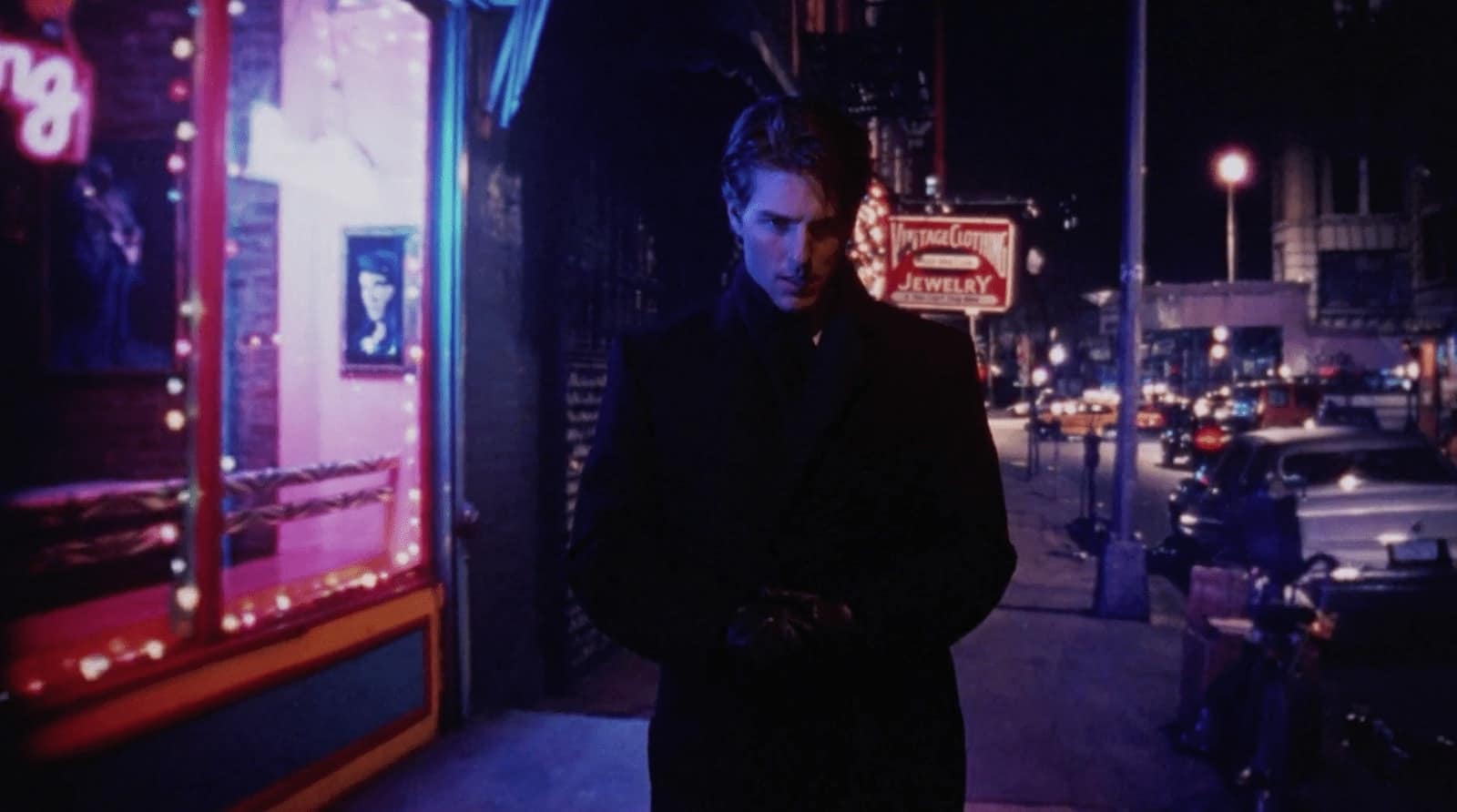
Process shots
The separation between Bill and the background is barely noticeable. But it does give the character an extra layer of disconnection. He is not present at this moment, literally and figuratively.
99% of filmmakers don't have the budget or resources to recreate Greenwich Village. But Kubrick's was in a rare position where budget was rarely a factor.
Building a set when a practical location is available can give your scenes added depth and meaning.
The process shot here must be communicated clearly because otherwise, a like this scene can look especially simple. And important elements could be missed the script breakdown. If we take look below...
Use scene notes to workshop ideas found in the script
The script breakdown allows you to highlight and tag all of the elements in a scene to better plan for what's needed once on set and how to schedule it. Here though, it seems like there aren't enough elements to tag. But because we know this is a potential opportunity for a process shot, we can highlight the heading as either "optical effects," or simply just write the game plan under "scene notes."
StudioBinder makes communicating creative ideas and plans simple. Also, feel free to use the comment feature on the right-hand side to chat with your team in real-time.
And you’ll want to communicate the process shots loud and clear on your stripboard so your 1st AD can schedule it appropriately.
Add your new locations on the stripboard
It will be vital to your production to use an intuitive scheduling feature that can be arranged and re-arranged at your convenience. When you find your locations you can populate them easily on the stripboard.
Related Posts
Location Scouting
Use existing locations
To create a dystopian London for A Clockwork Orange, Kubrick kept it simple. It is unclear how far into the future this story takes place but the clues are there.
The costumes and sound design are progressive. The language has clearly evolved. The car that Alex and his droogs take on a joyride is borderline "futuristic."
These elements might be enough to convince the audience that this is a different time and place. But there is one element that adds a great deal of credibility to this idea. The lynchpin that brings this world together:
Existing exterior locations.
Kubrick doesn't push this futurism. With a select group of practical locations, the world of the film is complete.
Consider this early scene as Alex ambles home along the rooftops. The buildings are a modernist design with straight and diagonal lines. They appear as a hybrid between industrial and suburban. A sign of progress.
We also have trash and furniture spread across the rooftop. Modern meets and squalor. Thus, we have a dystopian trope.
The same, subtle effect comes into play later. When Alex arrives at the Ludovico Treatment Center, he passes a large, concrete building. The modernist design suggests a futuristic setting without the need for flying cars. The bold, imposing design goes further to represent the oppressive regime Alex is at the mercy of.
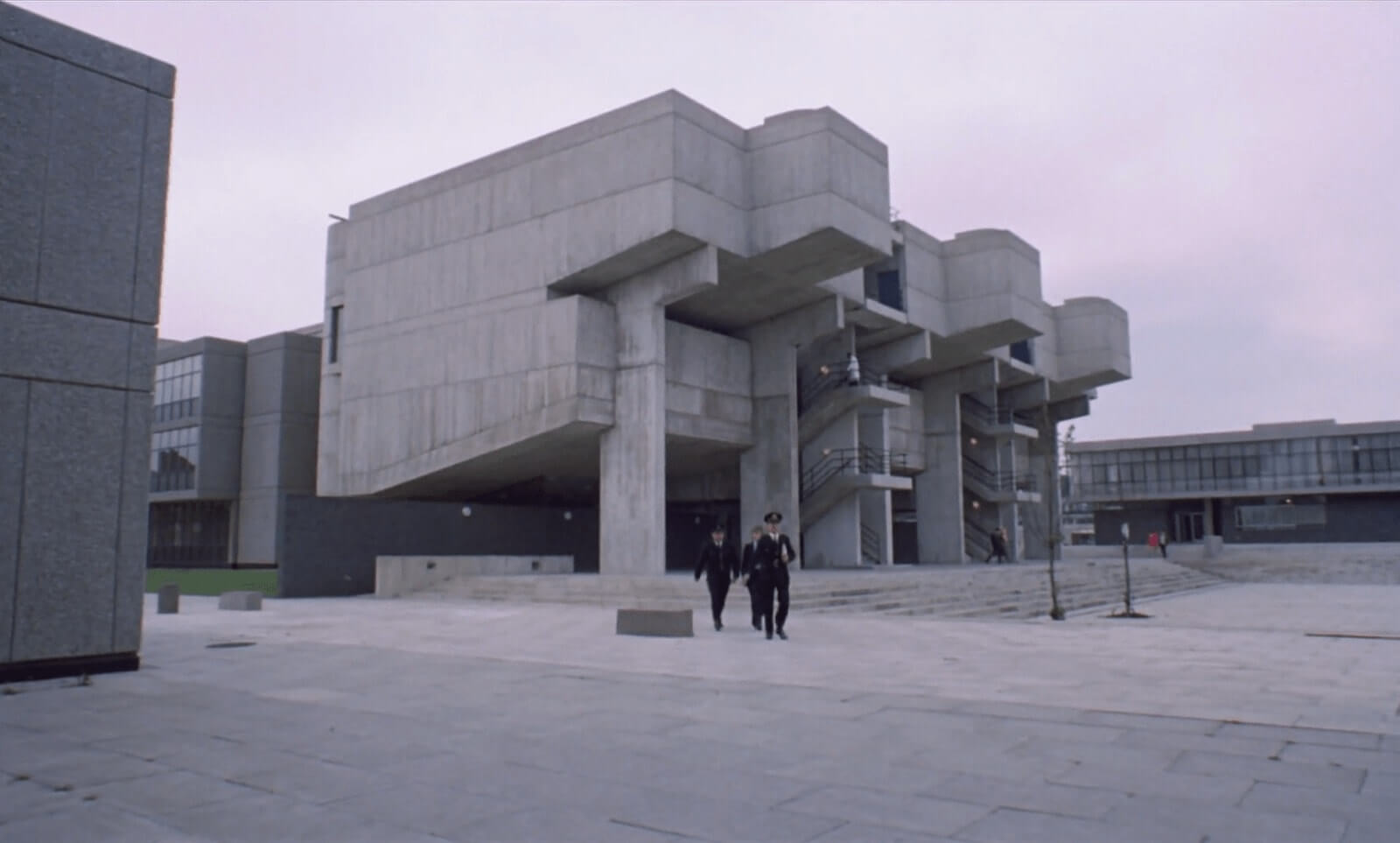
Ground your story with real places
Both the rooftop and Ludovico locations were pre-existing. By using them, even for a brief moment, the story is grounded. World building doesn't mean starting from scratch. It also doesn't mean pushing your budget passed reasonable. Look around and you will find what you need.
Thematic Architecture
Create bold spaces
Dr. Strangelove has one of the most iconic sets in Hollywood history: The War Room. The giant, round table and the massive, circular lighting around the perimeter.
The "big board" as Gen. Turgidson calls it. The sloping ceiling.
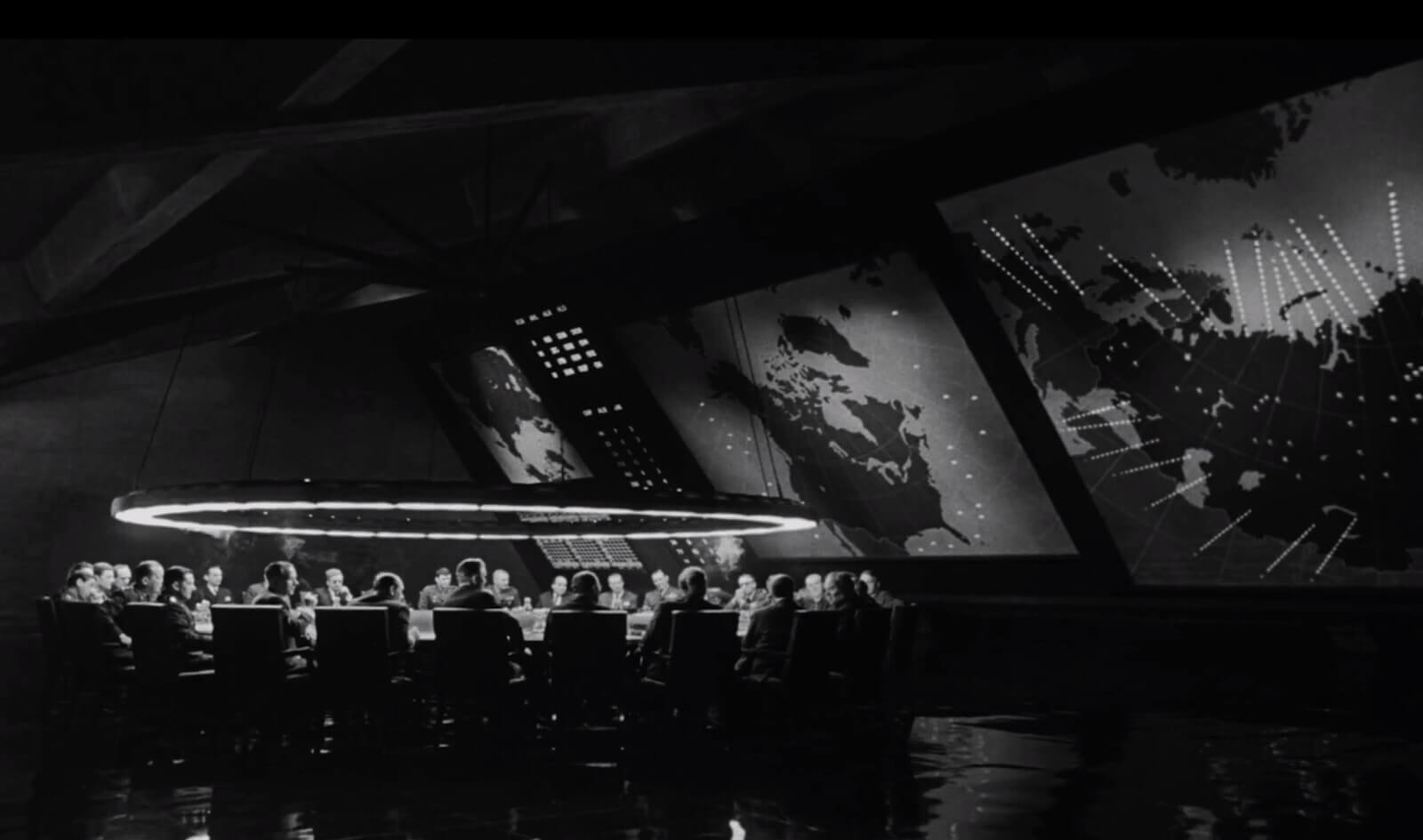
Space captures themes at length
It is a bold design. Beyond function, it is an imposing space. We get the idea that whoever built this room must be powerful and in control.
The genius of this design is that it's hubris matches that of the leaders who use it. A throne room for those who refuse to admit they actually wield no power.
This is why the dark comedy of Dr. Strangelove is so effective. The conflict of power and control is built into the set itself.
As things go awry in the film, that sense of power and control crumbles. The short-sightedness of our military is colossal. Gen. Turgidson's ego is massive. It is fitting then that the War Room's design would reflect that.
The dozens of men sitting around the table cannot fix this situation. The bells and whistles of "the big board" offer little comfort when human error takes over.
When meeting with your Production Designer, you can upload images into your StudioBinder project as reference points.
Auteur Theory Made Practical
Explore directing techniques used by the greats
Create works like these iconic auteur directors. Explore practical directing tips you can immediately put into action on your next project.
Explore More Auteur Directors
Kubrick's use of sets and locations are evocative and bold. But there are more layers to add that really flesh out these films: sound and music. In the next section, we'll close our eyes and open our ears to how Kubrick uses audio in a very Kubrickian way — from minimal to maximum.
3
Music and Sound
Dominant Scores and Minimal Sound Design
Dominant Scores
Redirect the scene with music
Music has the ability to dictate the direction of any scene. In fact, no other single element has such power in the filmmaking process.
Stanley Kubrick uses music in this capacity in many of his films. The music in 2001: A Space Odyssey, for example, is just as iconic and memorable as the imagery.
Let's take a look at how Kubrick wields the power of music in two distinct ways.
First, let's watch and listen to the scenes featuring the monolith. During the Dawn of Man sequence, the hominids awaken to the presence of a strange and foreign shape.
Dawn of Man sequence
On the soundtrack, an atonal drone of human voices rises in pitch and intensity. This is György Ligeti's piece entitled "Requiem." It is a shapeless and haunting piece and it dominates the scene.
As the scene progresses, the "voice" of the monolith overwhelms the soundtrack. The cries of the hominids are drowned out completely. The audience is also overwhelmed by the power of the monolith.
The same scene repeats later in the film when Dr. Floyd's team visits the monolith on the moon. "Requiem," again, overwhelms the scene, the characters, and the audience. In these moments, "Requiem" is chaos, danger, power.
Once we jump from the Dawn of Man to the space age, we have a sequence that uses music in a much different way. Johann Strauss's "Blue Danube Waltz" soundtracks a ballet in a space.
Don't limit your music choice
This light, playful piece marks the evolution of humanity with elegance and sophistication. Far from the screaming, violent hominids of our past, we have arrived at the apex of our abilities.
By using opposite compositions like "Requiem" and the "Blue Danube Waltz," you can create a juxtaposition that has a major impact on the direction, mood, and meaning of the scene. The trend these days is for the score to accent scenes, not take them over completely.
Is there a piece of music you could include your film that would change the direction of a scene? Make a note in your StudioBinder project breakdown.
Related Posts
Minimal Sound Design
Focus the tension with sound
One way Kubrick uses sound design in 2001: A Space Odyssey is to create tension. As HAL 9000 begins his mutiny, Kubrick doesn’t rely on the traditional methods to ramp up suspense.
He eliminates sounds.
Let’s take a look at two related scenes with diegetic sound design. When our protagonist, Dr. Bowman, completes a spacewalk, we only hear two things for almost seven minutes.
Breathing and compressed air. That's it.
By isolating these sounds, Bowman's breathing represents the only thing that matters: survival. It is a reminder to the audience how dangerous space can be. And how vital oxygen is in this unforgiving environment.
Later, during Dr. Poole's spacewalk, HAL makes his move. We listen to Dr. Poole's breathing, like Bowman's, until the moment HAL strikes.
Then?
Silence. Nothing. No screaming, no dramatic musical score. Only a man flailing through space and denied that ever-important oxygen.
Sound of death
We don't need sound or music at this moment to understand what is happening. He was breathing and then he stopped. It's that simple.
Sound design can be complex, minimal or non-existent. Think about where sound design might be the best way to communicate an idea to your audience.
Related Posts
Wrapping Up
What makes Kubrick movies so great?
Stanley Kubrick’s status as one of the greatest filmmakers and auteurs is rarely contested. His genius is a foregone conclusion and his work speaks volumes even if the man himself didn’t.
Filmmakers have been inspired and puzzled by Kubrick’s work for decades. As much as Stanley Kubrick movies are revered, they can also be difficult to dissect. They are enigmatic, multi-layered and dense.
We are amazed by them but it can be difficult to explain why.
4
Stanley Kubrick Filmography
13 Films in 46 Years
stanley Kubrick Films
Stanley Kubrick filmography
These aren't the "best Stanley Kubrick movies," this is the complete list. I mean there are only 13 of them...
Fear and Desire (1953)
Four soldiers trapped behind enemy lines must confront their fears and desires before it's too late.
Kubrick's First: Fear and Desire
Killer’s Kiss (1955)
Ready to catch a train to his hometown, a washed-up boxer tells us about the strange and twisty events that happened to him the past couple days.
Killer's Kiss
The Killing (1956)
Crook Johnny Clay assembles a five-man team to plan and execute a daring racetrack robbery.
Paths of Glory (1957)
After refusing to attack an enemy position, a general accuses the soldiers of cowardice and their commanding officer must defend them.
Kubrick's Path of Glory
Spartacus (1960)
The slave Spartacus leads a violent revolt against the decadent Roman Republic. Kubrick basically denounced this film upon release.
Lolita (1962)
A middle-aged college professor becomes infatuated with a fourteen-year-old nymphet.
Dr. Strangelove (1964)
An insane general triggers a path to nuclear holocaust that a War Room full of politicians and generals frantically tries to stop.
2001: A Space Odyssey (1968)
After discovering a mysterious artifact buried beneath the lunar surface, mankind sets off on a quest to find its origins with help from intelligent supercomputer HAL 9000.
A Clockwork Orange (1971)
In the future, a sadistic gang leader is imprisoned and volunteers for a conduct-aversion experiment, but it doesn't go as planned.
Barry Lyndon (1975)
An Irish rogue wins the heart of a rich widow and assumes her dead husband's aristocratic position in 18th-century England.
The Shining (1980)
A family heads to an isolated hotel for the winter where a sinister presence influences the father into violence, while his psychic son sees horrific forebodings from both past and future.
Full Metal Jacket (1987)
A pragmatic U.S. Marine observes the dehumanizing effects the Vietnam War has on his fellow recruits from their brutal boot camp training to the bloody street fighting in Hue.
Eyes Wide Shut (1999)
A New York City doctor embarks on a harrowing, night-long odyssey of sexual and moral discovery after his wife reveals a painful secret to him.
He didn’t complete many films in a nearly 50 year career. You can count the number of Stanley Kubrick movies on three hands. But the idea of quality over quantity has never been more true.
Auteur Theory Made Practical
Explore directing techniques used by the greats
Create works like these iconic auteur directors. Explore practical directing tips you can immediately put into action on your next project.
Explore More Auteur Directors
Up Next
The genius of David Fincher movies
If you appreciate the level of detail Kubrick demands in his work, discover more with David Fincher. Fincher's shot selection, his frugality with close-ups, and motivated camera work are explored in detail. Let's dive into some of his films demonstrating his directing style at work. Learn more about the style that has made him one of the (more recent) greats of his time.
Up Next: Fincher's style →
Showcase your vision with elegant shot lists and storyboards.
Create robust and customizable shot lists. Upload images to make storyboards and slideshows.
